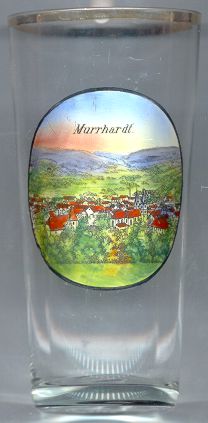

|
| DEUTSCHLAND | GERMANY |
| Bundesland: Baden-Württemberg | |
| Regierungsbezirk: Stuttgart | |
| Landkreis: Rems-Murr-Kreis |
 Murrhardt is situated at an elevation of 483 m on the river Murr in the Rems-Murr district of Baden-Württemberg.
Between AD 150 and 260 a Roman fort and a small settlement, called "vicus murrensis" (village at the Murr), existed on the Riesberg.
Around 260 the area was conquered by the Alemanni. By the 6th century the region had become part of the Frankish kingdom. The new
settlement, "Murrahart", is verified at least since the early 7th century. It is said that around 730 Saint Pirmin built a church at this place.
A small wooden chapel from that period could indeed be demonstrated by archaeological excavations. The oldest written mention of
the "cellula Murrhart", a hermitage, is found in a document from the year 788. Walterich, a noble clergyman who is belived by some
to have been an illegitimate son of Charlemagne, founded a Benedictine monastery here in 816/817. Soon after his death the first pilgrims
came to Murrhardt. Walterich was beatified in 1226/1227, and although he never was canonized by the Catholic church the local population
venerates him as "St. Walterich".
Murrhardt is situated at an elevation of 483 m on the river Murr in the Rems-Murr district of Baden-Württemberg.
Between AD 150 and 260 a Roman fort and a small settlement, called "vicus murrensis" (village at the Murr), existed on the Riesberg.
Around 260 the area was conquered by the Alemanni. By the 6th century the region had become part of the Frankish kingdom. The new
settlement, "Murrahart", is verified at least since the early 7th century. It is said that around 730 Saint Pirmin built a church at this place.
A small wooden chapel from that period could indeed be demonstrated by archaeological excavations. The oldest written mention of
the "cellula Murrhart", a hermitage, is found in a document from the year 788. Walterich, a noble clergyman who is belived by some
to have been an illegitimate son of Charlemagne, founded a Benedictine monastery here in 816/817. Soon after his death the first pilgrims
came to Murrhardt. Walterich was beatified in 1226/1227, and although he never was canonized by the Catholic church the local population
venerates him as "St. Walterich".
The Reformation was introduced in Murrhardt in 1534, and the monastery was finally dissolved in 1556. The Protestant abbots received the status of functionaries of the Duchy of Württemberg and reained this position until the Secularization of 1806. The Thirty Years' War (1618–1648) was a time of severe hardship for Murrhardt like for so many other places throughout Europe. The next catastrophe followed in 1765 when a large fire almost completely destroyed the old town. Although Duke Carl Eugen favoured plans for a new, Baroque town, the citizens of Murrhardt prefered to rebuild the town according to a 'Medieval' design with narrow streets and half-timbered houses. By 1790 the task of rebuilding the town was completed. After the Napoleonic wars the offices of the regional administration were moved to Backnang between 1806 and 1838. Nevertheless the town managed to grow further during the 19th century.
The opening in 1878 of the railroad to Murrhardt finally marked the "beginning of a new era", the industrialisation, for the town. Tourism also became
a new factor for the economy of Murrhardt. Until 1975 it was officially recognized as a climatic spa; since 1978 it again is recognized as a resort town.
In 1971 the municipalities Fornsbach and Kirchenkirnberg were incorporated into the municipality of Murrhadt which since then is the largest
municipality in the Swabian Forest region.
![[scale]](lineal.jpg)